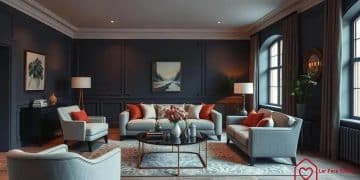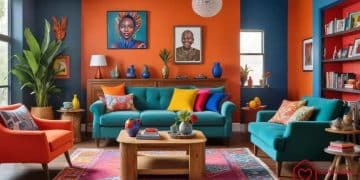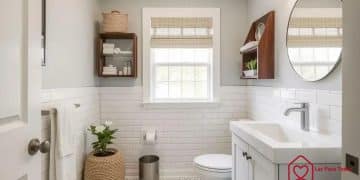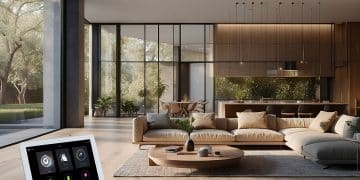Tips to transform your home: How to create an elegant and functional space

Transforming your home into a stylish and functional space doesn’t have to be a daunting task. See these tips to transform your home that we reunited for you!
By applying simple yet impactful interior design tips, you can refresh your living areas without needing a complete renovation.
Whether you want to brighten up a small room, add personality with accessories, or create multifunctional spaces, there are strategies to achieve every goal.
These tips are perfect for anyone looking to design their home’s interior with a focus on practicality and creativity.
Read on to explore practical advice and take the first step toward the home of your dreams.
The power of strategic lighting
Lighting plays a crucial role in defining the mood and functionality of your space.
A well-lit home feels inviting, spacious, and cozy, while poor lighting can make even a beautiful room feel lackluster.
Strategic lighting involves combining natural and artificial sources to meet your needs and enhance your interior design.
Layered lighting for depth and coziness
Layered lighting combines three types of illumination: ambient, task, and accent lighting.
- Ambient lighting, such as pendant lights, serves as the primary light source in a room.
- Task lighting, like desk lamps or under-cabinet lights in the kitchen, focuses on specific activities.
- Accent lighting, such as wall sconces or LED strips, adds a decorative touch.
For instance, pairing a chandelier with floor lamps and wall-mounted fixtures creates a cozy and versatile atmosphere.
Balancing these layers ensures your home is not only functional, but also visually pleasing.
Natural light as a game-changer
Nothing compares to the brightness and freshness that natural light brings to a home. Maximize natural light by using sheer curtains or going curtain-free in private areas.
Reflective surfaces like mirrors and glossy furniture amplify daylight, making rooms feel more open. Additionally, incorporating skylights or light-colored walls helps diffuse light evenly throughout the room.
Opt for energy-efficient LED bulbs when natural light isn’t available to maintain eco-friendly interior design.

Using mirrors to create space and elegance
Mirrors are a simple yet powerful tool for transforming a room. Their ability to reflect light and create the illusion of space makes them indispensable in interior design.
Strategic mirror placement
To make a small room appear larger, place mirrors opposite windows to reflect natural light across the space.
In narrow hallways or tight corners, a well-positioned mirror can open up the area, making it feel less confined.
Use full-length mirrors in bedrooms or entryways for added practicality and elegance.
Choosing the right frames and styles
Mirrors can also serve as decorative pieces. A statement mirror with a bold frame can act as a focal point in the living room, while minimalist frames blend seamlessly with modern decor.
Always choose mirrors that align with your home’s overall theme, whether rustic, industrial, or classic.
Color psychology: Soft tones for smaller rooms
Color is a critical component of interior design, as it influences the mood and perceived size of a room.
When used wisely, colors can transform your home into a haven of tranquility and style.
Best colors to create a sense of space
Soft tones like pastel blue, white, and light gray are perfect for smaller rooms, as they reflect light and make the space feel more open.
White walls, in particular, create a neutral base that allows furniture and accessories to stand out.
Avoid dark shades in confined spaces, as they absorb light and can make a room feel smaller.
Accents and contrast
Adding pops of color through accessories like cushions, throws, and artwork brings personality and vibrancy.
For example, a neutral living room can come to life with mustard yellow or emerald green cushions, achieving the perfect balance between subtlety and character.
Rugs: Beauty or Burden?
Rugs are a versatile design element that can anchor a room, add warmth, and introduce patterns or colors. However, they must be chosen carefully to avoid overwhelming the space.
Choosing the right size and placement
The size of the rug is crucial. A rug that’s too small can disrupt a room’s flow, while a large rug can tie everything together.
In living rooms, place the front legs of sofas and chairs on the rug to create a cohesive seating area. In dining rooms, ensure the rug extends beyond the table to accommodate chairs, even when pulled out.
Tips on materials and maintenance
Materials like wool and synthetic blends are durable and easy to maintain, making them ideal for high-traffic areas.
For homes with pets or children, opt for stain-resistant rugs. Regular vacuuming and occasional deep cleaning will help keep your rugs looking fresh and vibrant.

Adding life with indoor plants
Nothing breathes life into a home like greenery. Indoor plants are a cost-effective way to elevate your home’s aesthetics and improve air quality.
Best plants for homes
For climates with low maintenance needs, choose resilient plants such as succulents, snake plants, and rubber plants.
For a pop of color, consider flowering plants like African violets.
Placement and care tips
Place plants in well-lit areas, such as near windows or on shelves that receive indirect sunlight. Hanging pots or corner arrangements can maximize floor space while adding visual interest.
Remember to water regularly and occasionally fertilize your plants to keep them thriving.
Accessorizing with textiles for warmth and style
Textile accessories can transform your home by adding layers of comfort and texture.
Layering textures with cushions and throws
Mix and match materials like velvet, linen, and wool for a cozy yet stylish look.
A sofa adorned with velvet cushions and a knitted throw adds depth and a tactile experience that’s inviting and chic.
Curtain and upholstery options
Lightweight fabrics like cotton or linen brighten a space, while heavier materials like velvet add warmth and luxury.
Similarly, upholstered furniture can become a focal point when chosen in bold prints or vibrant colors, adding personality to your home.
Multifunctional spaces for modern living
As homes become more compact, multifunctional spaces are a necessity.
Smart furniture choices
Invest in multi-use furniture like sofa beds or coffee tables with hidden storage to maximize space.
These pieces are especially useful in small apartments or open-plan homes, where every square meter counts.
Effective space zoning
Use furniture arrangements or area rugs to delineate different functions in an open-plan space.
For instance, a bookshelf can act as a divider between a living room and dining area, creating the illusion of separate rooms without walls.

Transforming your home doesn’t require major renovations or a huge budget. By applying these practical interior design tips, you can create a stylish and functional space that reflects your personality.
From layering textures and playing with light to adding greenery, these small changes can make a big impact.
Ready to get started? Explore more ideas and guides on our website to keep improving your home, one room at a time!
Want a suggestion? Check out our content explaining how to make sustainable home improvements.






